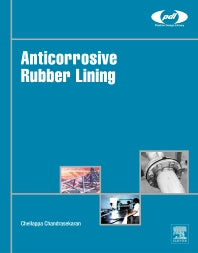Freshly Printed - allow 10 days lead
Couldn't load pickup availability
Anticorrosive Rubber Lining
A Practical Guide for Plastics Engineers
Offering a unique perspective on industrial rubber lining practices, including sections on the best materials and formulations to use and what's best for a particular application
Chellappa Chandrasekaran (Author)
9780323443715
Hardback, published 25 May 2017
294 pages
27.6 x 21.5 x 2.3 cm, 1.16 kg
Anticorrosive Rubber Lining discusses the state-of-the-art in this evolving industry, including sections on the best materials and formulations to use, what's best for a particular application, which repair technique is best for a given application, how long a rubber lining is likely to last, vulcanization parameters, and more. This book deals with the important field of anticorrosive rubber lining and its applications in various industries, including oil and gas, nuclear, aerospace, maritime, and many more, highlighting many of the technological aspects involved. The author offers a unique perspective due to the exclusiveness of the case histories presented, including many industrial rubber lining practices which are mostly kept within the industry. The technical information on rubber presented here is a practical tool to enable engineers to make the best use of rubber linings to prevent corrosion in chemical plants. The book includes valuable insights into bonding systems, surface preparation, and coating methodologies, and also covers failure analysis of failed systems.
1. Rubber: A Miracle Material2. Rubber for Corrosion Protection3. Wear resistance rubber compounds for ore and mining industries4. Corrosion resistance of biopolymers and thermoplastic elastomers5. Corrosion resistance of fluoro rubbers6. Rubber lining for sea water systems7. Rubber lining for oil field equipment8. Rubber lining for nuclear equipment9. Raw materials for rubber lining compounds10. Rubbers mostly used in process equipment lining11. Compounding procedures of rubber for lining applications12. Techno-economic aspects of non-rubber linings: FRP, Glass, and Lead13. Manufacturing and application procedures14. Adhesive formulations for Rubber to metal bonding systems in Rubber lining15. General rubber lining principles16. Design considerations for fabrication of equipment for rubber lining17. Testing of rubber lining18. Specifications and codes of practice19. Some typical process conditions in chemical industries20. Aging, service life, and predicting life of rubber lining21. Basic chemical resistance ebonite formulations22. Practical corrosion resistance rubber formulations23. Infrastructure for setting up a rubber lining shop24. Case studiesAppendices
Subject Areas: Rubber technology [TDCR], Plastics & polymers technology [TDCP], Engineering: general [TBC]


